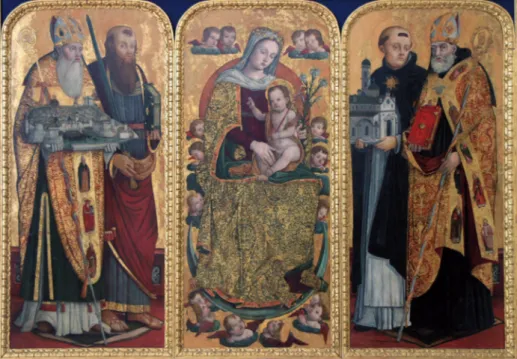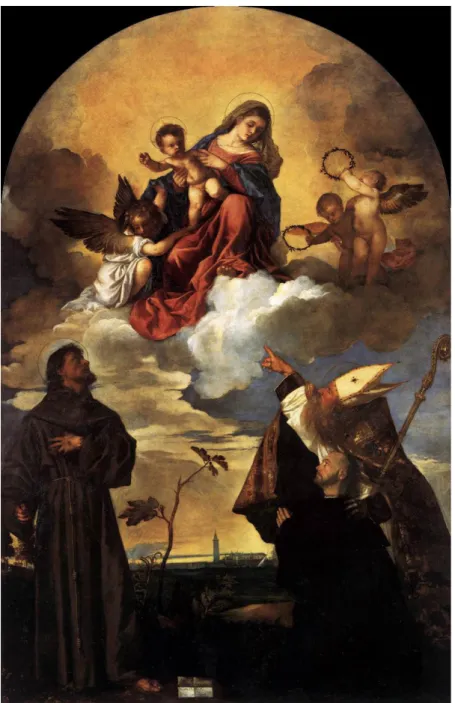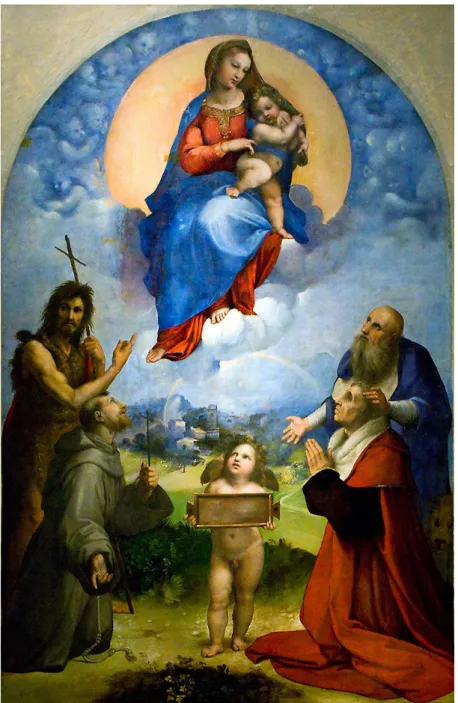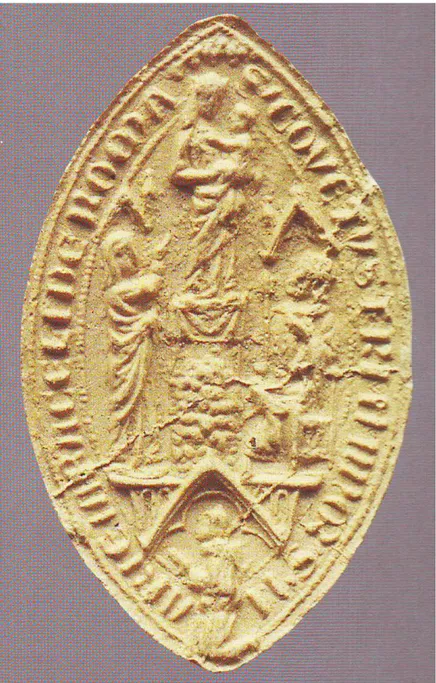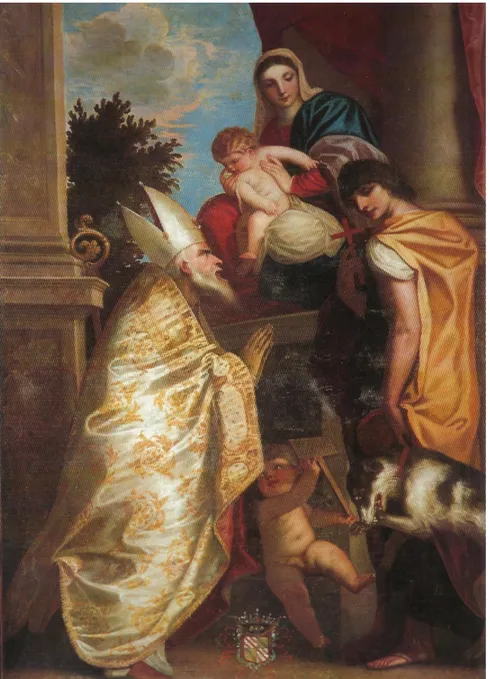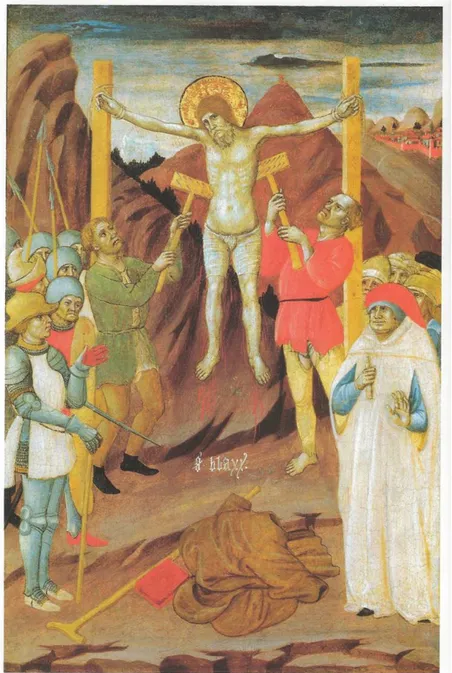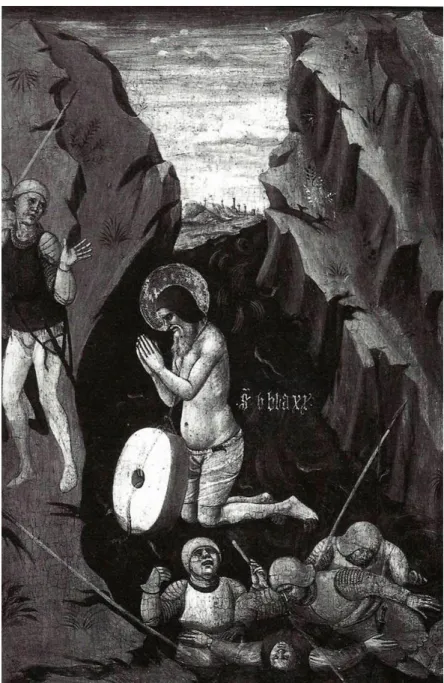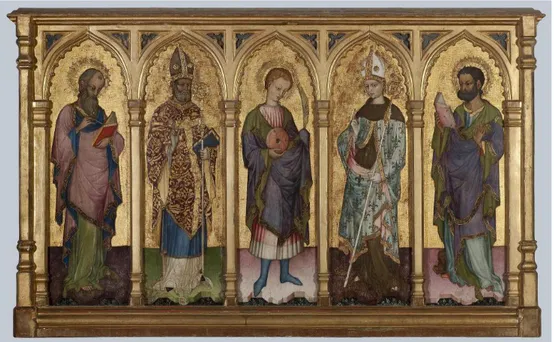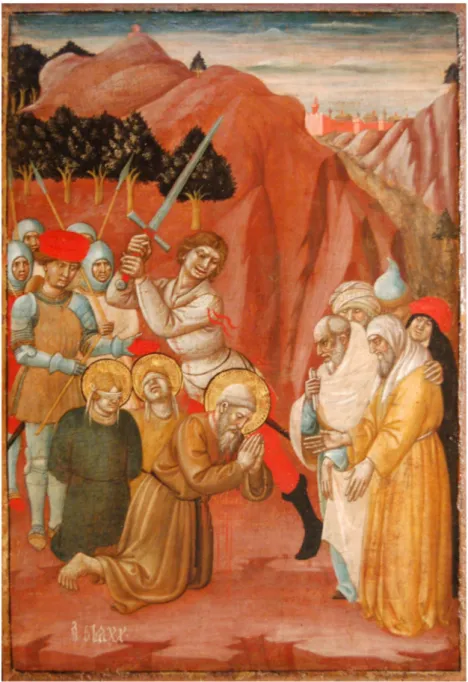JOURNAL OF THE SECTION OF CULTURAL HERITAGE
Department of Education, Cultural Heritage and Tourism University of Macerata
07
S
UPPLEMENTI
IL CAPITALE CULTURALE
Studies on the Value of Cultural Heritage
Visualizing Past in a
Foreign Country:
Schiavoni/Illyrian
Confraternities and Colleges
in Early Modern Italy
in comparative perspective
IL CAPITALE CULTURALE
Studies on the Value of Cultural Heritage
Supplementi 07
/
2018
Studies on the Value of Cultural Heritage Supplementi 07, 2018 ISSN 2039-2362 (online) ISBN 978-88-6056-565-5 Direttore / Editor Massimo Montella Co-Direttori / Co-Editors
Tommy D. Andersson, Elio Borgonovi, Rosanna Cioffi, Stefano Della Torre, Michela di Macco, Daniele Manacorda, Serge Noiret, Tonino Pencarelli, Angelo R. Pupino, Girolamo Sciullo
Coordinatore editoriale / Editorial Coordinator Francesca Coltrinari
Coordinatore tecnico / Managing Coordinator Pierluigi Feliciati
Comitato editoriale / Editorial Office
Giuseppe Capriotti, Mara Cerquetti, Francesca Coltrinari, Patrizia Dragoni, Pierluigi Feliciati, Valeria Merola, Enrico Nicosia, Francesco Pirani, Mauro Saracco, Simone Sisani, Emanuela Stortoni
Comitato scientifico - Sezione di beni culturali / Scientific Committee - Division of Cultural Heritage and Tourism
G i u s e p p e C a p r i o t t i , M a r a C e r q u e t t i , Francesca Coltrinari, Patrizia Dragoni, Pierluigi Feliciati, Maria Teresa Gigliozzi, Susanne Adina Meyer, Massimo Montella, Umberto Moscatelli, Sabina Pavone, Francesco Pirani, Mauro Saracco, Michela Scolaro, Emanuela Stortoni, Federico Valacchi, Carmen Vitale
Comitato scientifico / Scientific Committee Michela Addis, Tommy D. Andersson, Alberto Mario Banti, Carla Barbati, Sergio Barile, Nadia Barrella, Marisa Borraccini, Rossella Caffo, Ileana Chirassi Colombo, Rosanna Cioffi, Caterina Cirelli, Alan Clarke, Claudine Cohen, Lucia Corrain, Giuseppe Cruciani, Girolamo Cusimano, Fiorella Dallari, Stefano Della Torre, Maria del Mar Gonzalez Chacon,
Donato, Rolando Dondarini, Andrea Emiliani, Gaetano Maria Golinelli, Xavier Greffe, Alberto Grohmann, Susan Hazan, Joel Heuillon, Emanuele Invernizzi, Lutz Klinkhammer, Federico Marazzi, Fabio Mariano, Aldo M. Morace, Raffaella Morselli, Olena Motuzenko, Giuliano Pinto, Marco Pizzo, Edouard Pommier, Carlo Pongetti, Adriano Prosperi, A n g e l o R . P u p i n o , B e r n a r d i n o Quattrociocchi, Margherita Rasulo, Mauro Renna, Orietta Rossi Pinelli, Roberto Sani, Girolamo Sciullo, Mislav Simunic, Simonetta Stopponi, Michele Tamma, Frank Vermeulen, Stefano Vitali
Web
http://riviste.unimc.it/index.php/cap-cult e-mail
[email protected] Editore / Publisher
eum edizioni università di macerata, Centro direzionale, via Carducci 63/a – 62100 Macerata tel (39) 733 258 6081 fax (39) 733 258 6086 http://eum.unimc.it [email protected] Layout editor Marzia Pelati
Progetto grafico / Graphics +crocevia / studio grafico
Rivista accreditata AIDEA Rivista riconosciuta CUNSTA Rivista riconosciuta SISMED Rivista indicizzata WOS
This work has been fully supported by Croatian Science Foundation under the project number 2305 - Visualizing Nationhood: the Schiavoni/Illyrian Confraternities and Colleges in Italy and the Artistic Exchange with South East Europe (15th - 18th c.)
Confraternities and Colleges in Early Modern Italy in
comparative perspective
Visualizing Past in a Foreign
Country: Schiavoni/Illyrian
Confraternities and Colleges in
Early Modern Italy in comparative
perspective
edited by Giuseppe Capriotti, Francesca Coltrinari,
Jasenka Gudelj
«Il Capitale culturale», Supplementi 07 (2018), pp. 187-209 ISSN 2039-2362 (online); ISBN 978-88-6056-565-5 DOI: 10.13138/2039-2362/1843
The painting owned by the
Schiavoni Confraternity of Ancona
and the wooden compartments
with
Stories of St Blaise by
Giovanni Antonio da Pesaro*
Giuseppe Capriotti**
Abstract
The aim of this paper is to analyze the phenomenon related to the migration of the cult as well as the iconography of St Blaise towards the Italian Adriatic coast, due to * This work has been fully supported by Croatian Science Foundation under the project number 2305 - Visualizing Nationhood: the Schiavoni/Illyrian Confraternities and Colleges in Italy and the Artistic Exchange with South East Europe (15th - 18th c.).
** Giuseppe Capriotti, Assistant Professor, University of Macerata, Department of Education, Heritage and Tourism, piazzale L. Bertelli 1, 62100 Macerata, e-mail: [email protected].
This essay is a synthesis of some papers presented at two international conferences: the first (From Dubrovnik to the Italian Adriatic coast: the migration of the iconography of St Blaise and the story of a painting owned by the Confraternity of Schiavoni of Ancona) was presented at the Sixteenth Century Society Conference, held in Bruges, Belgium, in 2016 (18-20 August); the second (The wooden compartments with stories of St Blaise by Giovanni Antonio da Pesaro: a work commissioned by the Schiavoni confraternity of Ancona?) was presented at the international conference Visualizing Past in a Foreign Country: Schiavoni/Illyrian Confraternities and Colleges in Early Modern Italy in comparative perspective, held in Zagreb, Croatia, in 2017 (30-31 May). The author thanks Chiara Musio, Francesca Serpentini, Roberto Dell’Orso, Jasenka Gudelj, Tanja Trška, Ivana Čapeta Rakić, Ivana Prijatelj Pavičić, Valentina Živković, Ivana Čota, Matteo Mazzalupi.
individuals or groups of people who moved from the Dubrovnik Republic, where the saint was venerated as patron. In the paintings produced in the town between the 15th and the
18th century, St Blaise is always represented as a bishop carrying a model of the town in
his hand, to show the protection offered by the saint to the Republic. Because of different reasons and patronages, the cult of St Blaise is quite spread in Italy and Europe, however, as for the Italian Adriatic coast, it was promoted by the citizens who came from Dubrovnik for business reasons, as shown by the paintings commissioned to Titian by Alvise Gozzi (Ancona, in the Marche) and to Padovanino by Nikola Radolović (Polignano a Mare, in Puglia), both Ragusans. The essay eventually aims at proposing an analysis of some wooden compartments by Giovanni Antonio da Pesaro (15th century), representing the stories of St
Blaise, as a probable commission by the documented confraternity of St Blaise of Ancona, established by some Schiavoni people in the 15th century. The compartments, preserved in
various museums and collections, could be the remnant panels of the documented altarpiece belonging to the chapel of the Schiavoni confraternity in the church of St Dominic.
Lo scopo di questo saggio è analizzare il fenomeno della migrazione del culto e dell’iconografia di San Biagio verso la costa adriatica italiana, grazie al movimento di singoli o gruppi di persone provenienti dalla Repubblica di Dubrovnik, dove il santo era venerato come patrono. Nella pittura prodotta in questa città tra il XV e il XVIII secolo, San Biagio è infatti sempre rappresentato come vescovo con il modellino della città sulle sue mani, per dimostrare la protezione offerta dal santo alla Repubblica. Per diverse ragioni e patronati, il culto di San Biagio è abbastanza diffuso in Italia e in Europa, ma sulla costa adriatica italiana è stato promosso, in particolare, da cittadini trasferitisi da Dubrovnik per motivi economici, come testimoniano ad esempio i dipinti commissionati a Tiziano di Alvise Gozzi (Ancona, nelle Marche) e al Padovanino di Nikola Radolović (Polignano a Mare, in Puglia), entrambi ragusei. Il saggio si propone da ultimo di analizzare alcune tavole di Giovanni Antonio da Pesaro (XV secolo), rappresentanti storie di San Biagio, come probabile commissione della confraternita di San Biagio di Ancona, costituita nel XV secolo da Schiavoni. Gli scomparti, ora conservati in diversi musei e collezioni, potrebbero essere ciò che resta della documentata pala d’altare della cappella della confraternita degli Schiavoni nella chiesa di San Domenico.
1. Introduction
The aim of this paper is to analyze three wooden compartments of an altarpiece, attributable to Giovanni Antonio da Pesaro and representing the stories of St Blaise, as a possible work commissioned by the Schiavoni confraternity of
Ancona, in the Marche Region, in the 15th century. This “micro” case could be
a new chapter in the rich phenomenon of the migration of the cult as well as the iconography of St Blaise towards the Italian Adriatic coast, due to the movement of individuals or groups of people from Dubrovnik, the ancient Ragusa, where
the saint was worshipped as patron1.
Who exactly was St Blaise? According to the Legenda aurea by Jacopo da
Varazze2, who in the 13th century makes a synthesis of the previous Greek and
Latin versions of the legend of the martyr3, St Blaise was a bishop who lived in
Sebaste, in Asia Minor, under the rule of Diocletian. As soon as he was appointed a bishop, he was forced to hide in a retreat, in order to escape persecutions against Christians. In the cave where he was hiding, he repeatedly received the visit of wild animals, wounded or ill, and he healed them with his blessing. One day, the governor’s soldiers on a hunting session found him and caught him. Along the way, Blaise met a woman who was desperate since her son was in danger of dying because of a fish bone stuck in his throat. Blaise healed him with a blessing. Because he refused to worship pagan gods, Blaise was first tortured with the carder’s combs and then thrown into a pond. Making the sign of the cross, Blaise made the water as solid as the ground and avoided drowning. The governor then made his soldiers march into the pond, but they all drowned. At this point the governor had Blaise beheaded and his soul rose up to heaven. According to this legend, then, St Blaise does not have any direct relation with the city of Dubrovnik.
The relation between the saint and the South-Adriatic city is narrated by
Serafino Razzi, prior of the Dominican convent of Ragusa at the end of the 16th
century4. In his chronicle, the friar mentions a miracle that happened in 9715: the
parish priest don Stojko told the Senate that he had seen in night vision (maybe a dream) his church of St Stephan full of armed men and a bearded man with a crosier in his hand. The man first revealed that he was St Blaise and then said that he had chased away Venetian ships that had come to conquer the town. Following this legend, the saint becomes the guardian of the freedom of the Republic, first against Venice and then against the Ottomans. In the art of this city, in effect,
between the 15th and the 18th century, St Blaise is traditionally represented as a
bishop carrying a model of the city in his hand, to show the protection offered by
the saint to the Republic, as a guardian of the city walls and of the Ragusan fleet6.
This happens for instance in the polyptych by Nikola Božidarević, which is now
in the Dominican Museum of Dubrovnik (fig. 1)7.
For different reasons, the cult of St Blaise is quite spread around Italy and Europe: he becomes the guardian of harvests and animals and the “physician”
for throat diseases of the throat8; on the Italian Adriatic coast, however, his cult
was particularly promoted by citizens who came from Dubrovnik for business
2 Da Varazze 2007, pp. 204-207. On the importance of this text for the European culture cf.
Boureau 1984; Le Goff 2014.
3 Garitte 1955, 1955b.
4 On the presence of St Blaise in the Ragusan literature see: Stojan 2014. 5 Razzi 2011, p. 37; Razzi 1595, pp. 20-21.
6 Cf. Gjukić-Bender 2014, pp. 292-325; Fisković 2014, pp. 154-201. 7 Cvetnić 2007 and the entry in Vilać 2017, pp. 76-77.
reasons9. The case of the patronage of Lujo Gučetić (Alvise Gozze) in Ancona
and Marin Radolović in Polignano a Mare, both Ragusans, is quite meaningful10.
2. St Blaise for two Ragusans on the Italian Adriatic Coast
In his patronage Lujo Gučetić (Gozze or Gozzi in Italian), a Ragusan merchant resident in Ancona had used the hometown saint with a clear identity-defining
function. In 1520 Gučetić commissioned Tiziano Vecellio to paint the altarpiece
for the high altar of the Franciscan observant church of San Francesco ad Alto
(fig. 2)11. The relationship of the painting by Titian with the Madonna di Foligno
of Aracoeli by Raffaello (fig. 3), repeatedly highlighted by critics12, is very
significant in this case for the role played by St Blaise in the Ancona painting. As
well known, in his Madonna di Foligno, Raffaello was inspired by a lost fresco
by Pietro Cavallini in the apse of the church of Aracoeli13, whose iconography
scheme is documented by a seal, still preserved in the same Franciscan convent
(fig. 4)14. The seal, that mirrors the lost fresco by Cavallini, portrays on the left
the Tiburtine Sibyl, who points out the appearance of the Virgin with Child to Augustus, according to the well-known legend on the foundation of the church
of Aracoeli, also told by Jacopo da Varazze15. In the painting by Raffaello the
kneeling client Sigismondo de’ Conti16, accompanied by St Jerome, takes up the
place of Augustus in all respect, while the pointing action of the Tiburtine is carried out by St John the Baptist. From an iconographic point of view, St John shares the same gesture (the indicating finger) with the Tiburtine. Titian further elaborates this iconography: to the right, we see St Francis, patron of the church, while on the left the Dubrovnik client is being protected by St Blaise, who at
9 On the case of Puglia see Bianco 2009 and Lupis 2014; Cf. also Basile Bonsante 2006. 10 Cf. Tomić 2010.
11 For the circumstances of the commission cf. Gudelj 2010. 12 Ivi, pp. 86-88. More in general see Polverari 1988; Brock 2017. 13 Cf. De Vecchi 2002, pp. 244-246.
14 Cf. Tomei 1982; 2000, pp. 106-107.
15 In a sibylline key, the famous Ara Coeli legend develops a theme already dealt with in the
Greek version of the Chronographia by Giovanni Malalas (6th century), in which Augustus asked
the Pythia of Delphi who would reign after him. In divulging the Tiburtine Sybil as its protagonist instead of the Pythia, the Golden Legend by Jacopo da Varazze does nothing but resume a replacement already present in the Mirabilia Urbs Romae of the 12th century. To the manifested
wish of the Senate to venerate the emperor like a god, Augustus himself replies that he would ask the Sibyl beforehand if a man greater than himself would ever have been born. While the prophetess interrogates the oracle in the imperial chamber, a Virgin appears in a circle around the sun with a child in her lap, which the Sibyl indicates to him as an object of adoration. After this event, the emperor not only did not allow the Senate to worship him as a god, but founded the still existing Church of the Ara Coeli on the Campidoglio, in honor of the Virgin. Cf. Verdier 1982.
the same time shows him the appearance of the Virgin. St Blaise, who makes the gesture that was Tiburtina’s in Cavallini and the Baptist’s in Raffaello, here plays for Gozze the dual function of protecting and announcing the vision. In summing up Raffaello’s model, therefore, Titian reinforces the role of the patron of Dubrovnik.
In the following century, another Ragusan immigrant, that is, Marin Radolović uses the patron of Dubrovnik to remind his origin. Marin’s brother, Nikola Radolović, a descendant of a merchant family from Ragusa, had become a feudal lord of the Viceroyalty of Naples in 1604, acquiring the feud of Polignano
a Mare, ruled by his family until 171317. Nikola promoted the restoration of
the Franciscan observant complex of Santa Maria di Costantinopoli (today, Sant’Antonio), which was meant to become a sort of family sanctuary. For this church, his brother Marin commissioned an altarpiece to Alessandro Varotari, known as Padovanino, around 1626 selecting some very significant saints to celebrate his double homeland (fig. 5): on the right there is St Vito, patron of Polignano, portrayed while he is holding a dog by the leash; on the left, there is the patron of his family’s hometown, portrayed as a bishop, while an angel carries
his international attribute, the carder’s comb18. This latter is quite significant:
while in Dubrovnik the specific attribute of St Blaise is the model of the town, in
the rest of Europe it is the instrument of one of his tortures, the carder’s comb19.
3. The Schiavoni Confraternity of Ancona and its painting in the documentation
Already in the 15th century, St Blaise had a close relationship with the
Schiavoni of Ancona, one of the most important communities of immigrants,
settled in the multicultural port of Ancona in the modern period20. According
to the documentation produced between the 18th and early 19th century by the
confraternity of St Blaise of Ancona, groups of Schiavoni, fleeing from the plague,
had disembarked in the 15th century on the coast of Ancona, where they founded
a confraternity dedicated to St Blaise21. The existence of this confraternity, that
in the 15th century had an altar in the Dominican church, is confirmed by some
notarial documents, found by Matteo Mazzalupi22: in 1476 Guccino di Bonanno
from Ragusa (this provenance is quite important) leaves a florin cappelle Sancti
17 Basile Bonsante 2002, pp. 75-100. 18 Ivi, pp. 90-91.
19 See for example the case of Ascoli Piceno: Capriotti 2016. 20 Cf. Hansen 2004.
21 See Capriotti in print.
22 Some documents are quoted in Mazzalupi 2008, pp. 180-181, note 28; other documents are
quoted in an unpublished entry written by Matteo Mazzalupi for the company Altomani&Sons. I would like to thank Mazzalupi for this reference.
Blaxii site in ecclesia Sancti Dominici de Ancona23; in 1498 Gregorio di Giovanni
called Zingaro (the gypsy) requests to be buried in the Dominican church in
sepulture confraternitatis Sancti Blasii ante altare Sancti Blasii, delivering 5 ducats
to use in uno Sancto Ieronimo fiendo in dicto altare, probably a sculpture, now
lost24. In this context, the documented reference to St Jerome is quite interesting
because in the 15th century the author of the Vulgate had become the saint
representative of the Illyrian nation25, as testified by the dedication to him of the
national church of the Croatians in Rome26.
According to an inventory compiled in 1791, the Schiavoni origin of the confraternity would be documented by a painting found in the church of St Blaise
in Poggio, near Ancona, site of the first organized community of Schiavoni27.
However, the painting is not described in the document. A painting, brought by the Schiavoni that settled in Poggio, is mentioned in the 1817 inventory, in which it is stated that they had brought from Schiavonia «a Painting portraying the Madonna with Child in her arms, St Blaise, highly worshipped by them, and underneath the image of the Purgatory with various souls, and a young boy that,
with a vase, poured water over the purifying fire»28. According to this source, the
“painting” had the same identical subject of the one now preserved in the church of St Blaise in Ancona, made out by Domenico Simonetti known as Magatta
in the 18th century29 (fig. 6). In the 1808 inventory compiled by the Schiavoni
confraternity of St Germano of Camerano, near Ancona, another painting is mentioned, owned by the confraternity of Ancona, which should portray the
landing of the Schiavoni at Numana, on the Conero coast30. So far we have no
trace of this painting and the accounts about it are clearly discordant: according to the 1791 inventory, the painting found under the altar of St Blaise in Poggio would reveal the Schiavoni origin of the brotherhood, but it is not specified how; according to the 1817 inventory, the Schiavoni had brought with them a painting, which should be identical in its iconography to the one that is today on the altar of the church of St Blaise in Ancona; according to the inventory of St Germano, the painting should represent the landing of the Schiavoni on the shore of Numana.
23 Archivio di Stato di Ancona, Archivio Notarile di Ancona, 65, notaio Melchiorre Bernabei,
II fasc., c. 27r-v.
24 Archivio di Stato di Ancona, Archivio Notarile di Ancona, 137, notaio Girolamo Sevini, cc.
483r-484r.
25 Ivić 2016. See also: Rice 1987. 26 Cf. Gudelj 2015.
27 Archivio Diocesano di Ancona (hereinafter ADAN), S. Biagio. Regole Storia (1768-1943),
Inventario (1791), p. 3.
28 «un Quadro in cui vi era dipinta la Madonna Santissima col Bambino in braccio, Santo
Blasio da essi tenuto in somma venerazione, e sotto poi a detta figura vi era il Purgatorio con varie anime, ed un Donzello con vaso di acqua, che versava su quel purgante fuoco»: ADAN, S. Biagio. Regole Storia (1768-1943), Platea (1817), p. 3.
29 Cf. Capriotti in print. 30 Cf. Toccaceli 1991, p. 49.
Regardless of the problems posed by this discordant documentation, starting from 1444, the Schiavoni of the confraternity of St Blaise of Ancona definitely possessed a painting that adorned their altar in the St Dominic church in the
town31. In 1717, when the Dominicans decided to renew their church, the
brothers were forced to transfer their painting to a new chapel in Calamo, which was built in 1718. In 1728 an inventory of the main altar of this chapel describes an altarpiece representing the Madonna with Child in the center, on the right St Blaise and St Mary Magdalen and on the left St Jerome and St Lucy. St Blaise and St Jerome, the saints that identify the Schiavoni, are also replicated in two statues in the gilded frame of the altarpiece. When St Blaise church was rebuilt in 1748, this altarpiece, now lost, was surely replaced with the abovementioned work by Magatta. This painting actually defines the new role of the confraternity, which is no longer to keep Illyrian customs alive but to soothe the pains of the souls in purgatory with their prayers. In fact, in the painting, the Virgin and St Blaise are interceding with Christ to save the souls in Purgatory, whose sorrows find some
relief in the water poured from the donzello, a young man wearing the dress of
the confraternity of St Blaise32.
4. The compartments of the altarpiece by Giovanni Antonio da Pesaro
Today, there is no trace of the painting mentioned in the reports representing the origin of the Schiavoni confraternity, once in the Dominican church in Ancona. Nevertheless, it is possible to develop a hypothesis formulated in 2008 by Matteo Mazzalupi, who dubiously proposed to identify the three works by Giovanni Antonio da Pesaro as the surviving compartments of the old altarpiece
of the Schiavoni altar in the Dominican church33. Federico Zeri included these
works in the catalog of Giovanni Antonio da Pesaro in 194834, a painter that
had been active in the Marca of Ancona for a long time, from 1441 to 1475,
year of his death (even if he is documented in Pesaro in 1459)35. The three stories
of St Blaise, due to their size, cannot be considered compartments of a predella.
More likely, they were compartments of a hagiographic altarpiece following the Venetian model, with the saint in the middle and stories on the sides, similar
to the Stories of St Lucy by Jacobello del Fiore or the Stories of St Elpidio by
Giacomo di Nicola da Recanati36.
31 Cf. Capriotti in print.
32 For a more detailed story see Capriotti in print. 33 Mazzalupi 2008, p. 180.
34 Zeri 1948.
35 Cf. Berardi 1988; Mazzalupi 2008, pp. 178-180 and pp. 210-223 (chapter written by
Alessandro Marchi).
The compartment now in the museum of Palazzo Venezia in Rome depicts the torture with the carder’s comb (fig. 7). Before being hanged on two poles in the form of a crucifix, St Blaise was undressed: in the foreground, there is, in fact, his garment, his cane, and a book. Two persecutors in tattered clothes are torturing him with two carder’s combs, while two groups of people are observing on the right and on the left.
The compartment now in an unknown collection (fig. 8) represents the moment when Blaise, thrown into the lake, does not drown, unlike the soldiers persecuting him. At the center of the image, St Blaise is still naked while praying with palms united, with a big stone wheel hanging on his neck, despite which
the martyr does not sink. This wheel tied to his neck is not present in the Golden
legend by Jacopo da Varazze. Among four legends of the martyr published in
the Acta Sanctorum, only one tells us that St Blaise was punished «marmoreo
pondere ad collum eius ligato»37. However, the generic weight quoted in the
legend becomes a millstone in the painting38. This detail creates a figurative
connection with the martyrdom of another saint highly venerated in the Dalmatian coast, St Anastasius from Solin (the laundryman), who is, together with St Domnius, one of the patron saints of the city of Split. According to his
legend, St Anastasius was thrown into the sea with a stone hung on his neck39;
in his iconography this stone becomes a wheel of a millstone, his most common
attribute40, as it is evident in the relief by the Master Otto in the Cathedral
of Split41, in the tomb of the martyr conceived by Juraj Dalmatinac for the
same Cathedral42 and in the polyptych by Dujam Vušković, coming from the
Franciscan church in Split and today preserved at the Hermitage (fig. 9)43.
Therefore, in the painting by Giovanni Antonio da Pesaro, St Blaise seems to appropriate the attribute of another Dalmatian saint, St Anastasius, probably to create a visual link between the two much-venerated saints on the Dalmatian coast.
The last compartment, which was owned by the antiquarian Altomani and which is now in another private collection (fig. 10), portrays the beheading of the saint. St Blaise prays again with his palms united, while a rogue is about to decapitate him together with two banded boys, who are also present in the legend of the saint. On the right, some characters dressed in Oriental clothes
37 Acta Sanctorum Februarii 1658, p. 352. Although this detail is rather rare, it is mentioned in
a passion of St Blaise rewrote in 1752. Cf. Niccolai 1752, p. 51.
38 The representation of the weight tied to the neck of St Blaise is quite rare in his iconography.
It misses for instance in a compartment of the predella in the polyptych by Sano di Pietro (Siena, Pinacoteca Nazionale) and in the cycle of frescos by Giacomo Jaquerio in Sant’Antonio di Ranverso (Buttigliera Alta, TO). Cf. Colafranceschi et alii 2014, p. 26 and p. 36.
39 Acta Sanctorum Septembris 1750, p. 23: «ut suspenso in collo eius lapide in mare mitteretur».
On this legend see Delehaye 1897; Jarak 1997.
40 Cf. Prijatelj 1978. 41 Goss 2010, p. 126.
42 Ivanišević 1982; Prijatelj 1989; Ivanišević 1989. 43 De Marchi 1996.
observe the scene: one wears a pointed hat, another a turban, and another a
shawl similar to a Jewish tallit44. Their appearance, therefore, is similar to that
of the Jews in a scene of Crucifixion, although in this context they seem to have a more positive function as if they were merely the Eastern companions of the martyr.
Since the iconography of St Blaise along the west coast of the Adriatic is generally linked to the cult of the saint, promoted by individuals or communities of Schiavoni in their new homeland (the quoted cases of the patronage of
Lujo Gučetić in Ancona and Marin Radolović in Polignano a Mare may be
the most famous examples), I think that the three stories of Giovanni Antonio da Pesaro could really be fragments of the “mysterious” painting mentioned in the conflicting documentation at the origins of the Schiavoni confraternity of Ancona. The altarpiece by Giovanni Antonio da Pesaro could have been dismembered and dispersed after 1718, with the transfer of the confraternity from the Dominican church to the new chapel, and replaced with a new altarpiece already documented in the inventory of 1728.
5. A final Adriatic comparison
I would like to finally propose a comparison with the case of a painting
dating to the end of the 16th century and now kept in the church of St Andrea
in Barletta, in Puglia (fig. 11). The existence of a confraternity entitled to St
Blaise had been documented in this town already in the 16th century, but we do
not know whether it was founded by Ragusans and whether this confraternity
commissioned the painting45. However, in this hagiographic altarpiece, St
Blaise is portrayed as a bishop in the act of blessing, holding a crosier and the model of Ragusa. The presence of this detail, which is the special attribute of St Blaise in Dubrovnik, makes us assume that the painting was commissioned by Ragusans that had moved to a new country. Indeed, it would make no sense to portray the saint in Barletta with the model of Ragusa. This artwork is also very important because it is one of the rarest examples of a hagiographic altarpiece dedicated to St Blaise, as should have been the one by Giovanni Antonio da Pesaro before its dismembering. Behind the still figure of the saint we can see some episodes of his life: on the top left, St Blaise is portrayed as hermit healing some wild animals, whereas at the bottom left he is healing the boy with the fishbone in his throat with his blessing; on the top right, Blaise is being tortured with the combs, while in the scene at the bottom he is beheaded.
In conclusion, it is possible to observe how, along the west coast of the Adriatic, from Marche to Puglia, the Schiavoni patronage has very similar
44 On the attributes of the Jews in the iconography see Capriotti 2014, pp. 13-17. 45 Lupis 2014, pp. 143-146.
features, using St Blaise to recall their motherland and distinguish themselves from the Other. Furthermore, both in Barletta and in Ancona, the confraternity of Schiavoni promoted the saint from Ragusa with a hagiographic altarpiece in Venetian style.
References / Riferimenti bibliografici
Acta Sanctorum Februarii (1658), I, Paris: Société des Bollandistes. Acta Sanctorum Septembris (1750), III, Paris: Société des Bollandistes.
Basile Bonsante M. (2002), Arte e devozione. Episodi di committenza meridionale
tra Cinquecento e Seicento, Galatina (Lecce): Congedo.
Basile Bonsante M. (2006), Mercanti di Ragusa e pittura veneta sulle coste
dell’Adriatico tra Cinque e Seicento, in Viaggiatori dell’Adriatico: percorsi di viaggio e scrittura, edited by V. Masiello, Bari: Palomar, pp. 249-276.
Berardi P. (1988), Giovanni Antonio Bellinzoni da Pesaro, Fano: Nuova Alfa.
Bianco R. (2009), Un Santo taumaturgo dall’Armenia alla Puglia: culto e
iconografia di San Biagio di Sebaste tra Medioevo ed Età Moderna, in I santi venuti dal mare, Atti del V Convegno internazionale di studio (Bari-Brindisi,
14-18 dicembre 2005), edited by M.S. Calò Mariani, Bari: M. Adda, pp. 367-392.
Boureau A. (1984), La légende dorée. Le système narratif de Jacques de Voragine
(†1298), Paris: Cerf.
Brock M. (2017), La place du spectateur dans la «Pala Gozzi» de Titien, in Voir
l’au-delà: l’expérience visionnaire et sa représentation dans l’art italien de la Renaissance, Actes du colloque international (Paris, 3-5 juin 2013), edited by
A. Beyer, P. Morel, A. Nova, Turnhout: Brepols, pp. 279-297.
Capriotti G. (2014), Lo scorpione sul petto. Iconografia antiebraica tra XV e
XVI secolo alla periferia dello Stato Pontificio, Roma: Gangemi, pp. 13-17.
Capriotti G. (2016), The Cauldron of St. Venera and the Comb of St. Blaise.
Cult and Iconography in the Confraternities of Albanians and Schiavoni in Fifteenth Century Ascoli Piceno, «Confraternitas», 27, 1, pp. 30-45.
Capriotti G. (in print), Ricordare le origini schiavone nel Settecento. La chiesa e
la confraternita di San Biagio ad Ancona, «Giornale di storia», in print.
Colafranceschi S., Contri T., Grimaldi Fava C., eds. (2014), San Biagio Patrono
di Cento. Iconografia, arte e devozione in Italia, Argelato: Minerva.
Cvetnić S. (2007), Božidarevićev Triptih obitelji Bundića i ikonografija Marije u
Suncu, «Radovi Instituta za povijest umjetnosti», 31, pp. 73-79.
Da Varazze I. (2007), Legenda aurea, edited by A. e L. Vitale Brovarone, Torino:
Einaudi.
De Marchi A. (1996), Un polittico spalatino di Dujam Vušković a Hermitage,
De Vecchi P. (2002), Raffaello, Milano: Rizzoli.
Delehaye H. (1897), S. Anastase martyr de Salone, «Analecta Bollandiana», XVI,
pp. 488-500.
Fisković I. (2014), Skulpturalno predstavljanje dubrovačkog Parca, in Sveti
Vlaho u povijesti i sadašnjosti, edited by P. Vilać, Dubrovnik: Dubrovački
muzeji, pp. 154-201.
Garitte G. (1955), La Passion di S. Irénarque de Sébastée et la Passion de S.
Blaise, «Analecta Bollandiana», LXXIII, pp. 18-54.
Garitte G. (1955b), La Passion arménienne de Saint Blaise, «Le Muséon»,
LXVIII, pp. 47-54.
Gjukić-Bender V. (2014), Sveti Vlaho – trajno nadahnuće slikara, in Sveti Vlaho
u povijesti i sadašnjosti, edited by P. Vilać, Dubrovnik: Dubrovački muzeji,
pp. 292-325.
Goss V.P. (2010), Four centuries of European art: 800-1200. A view from
southeast, Zagreb: Golden marketing, Tehnicka knjiga.
Gudelj J. (2010), Ponuda kakva se ne odbija: narudžba Tizianove pale Luja
Gučetića za franjevačku opservantsku crkvu u Anconi (L’offerta impossibile da declinare: la committenza di Luigi Gozze della pala d’altare di Tiziano Vecellio per la chiesa francescana degli Osservanti a Ancona), in Umjetnost i naručitelji. Zbornik radova znanstvenog skupa “Dani Cvita Fiskovića” održanog 2008. godine, edited by J. Gudelj, Zagreb: s.e., pp. 81-92.
Gudelj J. (2015), San Girolamo dei Croati a Roma: gli Schiavoni e il cantiere
sistino, in Identità e rappresentazione. Le chiese nazionali a Roma, 1450-1650, edited by A. Koller, S. Kubersky-Piredda, Roma: Campisano, pp.
297-325.
Hansen M.S. (2004), Immigrants and Church Patronage in Sixteenth-Century
Ancona, in Artistic exchange and cultural translation in the Italian Renaissance city, edited by S.J. Campbell, S.J. Milner, Cambridge: Cambridge University
press, pp. 327-354.
Ivanišević M. (1982), Juraj Dalmatinac u Splitu godine 1444. i 1448., «Radovi
Instituta za povijest umjetnosti», 3-6, pp. 143-157.
Ivanišević M. (1989), Liturgijski opisi oltara Svetoga Staša u Splitskoj prvostolnoj
crkvi, «Prilozi povijesti umjetnosti u Dalmaciji», 28, 1, pp. 33-50.
Ivić I. (2016), The cult of Saint Jerome in Dalmatia in the Fifteenth and the
Sixteenth Centuries, MA Thesis in Medieval Studies, Budapest: Central
European University.
Jarak M. (1997), Passio sancti Anastasii martyris, «Opvscvla archaeologica», 21,
1, pp. 151-165.
Le Goff J. (2014), Il tempo sacro dell’uomo. La Legenda aurea di Iacopo da
Varazze, Roma-Bari: Laterza.
Lupis V.B. (2014), O dubrovačkoj baštini u Italiji i nepoznatim prikazima sv. Vlaha
u Barletti (The Dubrovnik Heritage in Italy and Unfamiliar Representations of Saint Blaise in Barletta), «Naše more», 61 (5-6), pp. 140-146.
Mazzalupi M. (2008), Pittori ad Ancona nel Quattrocento, in Pittori ad Ancona nel Quattrocento, edited by A. De Marchi, M. Mazzalupi, Milano: Motta,
pp. 97-331.
Niccolai A. (1752), Memorie storiche di S. Biagio vescovo e martire protettore
della repubblica di Ragusa, Roma: per Giovanni Generoso Salomoni alla
Piazza di S. Ignazio.
Polverari M., edited by (1988), Tiziano. La pala Gozzi di Ancona: il restauro e il
nuovo allestimento espositivo, Bologna: Grafis Edizioni.
Prijatelj I. (1989), Prilog ikonografiji solinskog mučenika Sv. Staša, «Prilozi
povijesti umjetnosti u Dalmaciji», 28, 1, pp. 177-181.
Prijatelj K. (1978), Sv. Dujam i sv. Staš u likovnoj umjetnosti, «Peristil: zbornik
radova za povijest umjetnosti», 21, 1, pp. 103-119.
Razzi S. (1595), La storia di Ragusa. Scritta nuovamente in tre libri, Lucca: Per
Vincentio Busdraghi.
Razzi S. (2011), Povijest Dubrovnika, Dubrovnik: Matica hrvatska Dubrovinik.
Rice E.F. (1988), Saint Jerome in the Renaissance, Baltimore: Johns Hopkins
University Press.
Russo D. (1987), Saint Jérôme en Italie. Étude d’iconographie et de spiritualité
XII-XV siècle, Rome: École française de Rome.
Sensi M. (2014), La Madonna di Foligno e il suo committente Sigismondo dei
Conti d’Antignano, «Bollettino storico della città di Foligno», 37, pp. 75-186.
Stojan S. (2014), Sveti Vlaho u hvatskoj književnosti, in Sveti Vlaho u povijesti i
sadašnjosti, edited by P. Vilać, Dubrovnik: Dubrovački muzeji, pp. 358-389.
Tchouhadjian A. (2004), Saint Blaise, évêque de Sébaste, Paris: L’Harmattan.
Toccaceli F. (1991), San Germano. Una chiesa di Schiavoni. Appunti e documenti
per una storia della Parrocchia fra Quattrocento e Cinquecento, Camerano:
Cassa Rurale ed Artigiana “S. Giuseppe”.
Tomei A. (1982), Un contributo per il perduto affresco dell’Aracoeli, «Storia
dell’Arte», 44, pp. 83-86.
Tomei A. (2000), Pietro Cavallini, Cinisello Balsamo: Silvana Editoriale.
Tomić R. (2010), Lujo Gučetić i Nikola Radolović, dubrovački naručitelji
Tizianovih i Caravaggiovih slika (Luigi Gozze e Nicola Radolovich, i committenti ragusei di Tiziano e Caravaggio), in Umjetnost i naručitelji. Zbornik radova znanstvenog skupa “Dani Cvita Fiskovića” održanog 2008. godine, edited by J. Gudelj, Zagreb: s.e., pp. 93-100.
Verdier P. (1982), La naissance à Rome de la vision de l’Ara Coeli. Un aspect de
l’utopie de la paix perpétuelle à travers un thème iconographique, «Mélanges
de l’école française de Rome. Moyen Age Temps Modernes», 94-1, pp. 85-119.
Vilać P., ed. (2017), Nikola Božidarević. Veliki slikar dubrovačke renesanse,
Dubrovnik: Dubrovački muzeji.
Appendix
Fig. 5. Padovanino, Pala Radolović, Polignano a Mare, Church of Santa Maria di Costantinopoli
Fig. 6. Domenico Simonetti, called il Magatta, Christ, the Virgin, St Blaise and the souls of the Purgatory, Ancona, Church of St Blaise
Fig. 9. Dujam Vušković, Polyptych from the Franciscan church of Split, Saint Petersburg, Hermitage
eum edizioni università di macerata
Direttore / Editor
Massimo Montella
Texts by
Giuseppe Bonaccorso, Laris Borić, Giuseppe Capriotti,
Francesca Coltrinari, Jasenka Gudelj, Ines Ivić,
Neven Jovanović, Ana Marinković, Daniel Premerl,
Anita Ruso, Danko Šourek, Tanja Trška, Anatole Upart
http://riviste.unimc.it/index.php/cap-cult/index
ISSN 2039-2362
Department of Education, Cultural Heritage and Tourism
University of Macerata
ISBN 978-88-6056-565-5
